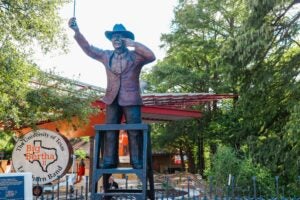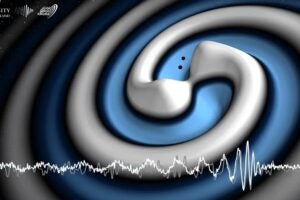AUSTIN, Texas—The memoir of a Mexican army officer serving under Santa Anna — which, when translated into English in 1975, became a new Alamo battle cry — is apparently authentic, said a University of Texas at Austin forgery expert.
After several weeks of evaluation, David Gracy said he has found that the memoir’s paper is consistent with the materials of the period, and watermarks in the Peña paper match watermarks in the paper used by the Mexican army of the time. Gracy, who teaches a UT Austin class on forged historical and literary documents and is a nationally known authority on archival enterprise, will conduct more tests, including elemental analysis of the ink. “Ours is a work in progress,” he said.
“So far, the physical characteristics point to it being genuine. We see no signs that the memoir has been tampered with,” said Gracy, who was a featured speaker at a recent University conference on the subject. Nearly 400 historians, writers and Texana buffs gathered at the LBJ Auditorium to hear discussions surrounding the memoir written by Lt. Col. Josÿ Enrique de la Peña.
Gracy, University students and two other instructors have been conducting tests on the memoir in the labs of UT’s preservation and conservation studies program. He said UT has given him “free rein” to examine the document. The tests, of course, do not address whether what Peña wrote is true.
Of particular interest and controversy has been Peña’s account of Davy Crockett’s death. According to Peña, Crockett did not go down fighting at the Alamo, but was captured and executed shortly after the battle.
This one paragraph, said another speaker, has emerged from the document “like a two-headed snake.” Dora Elizondo Guerra, a free-lance consultant specializing in interpreting and translating 18th and 19th century Spanish manuscripts, said the paragraph has taken on a life of its own — to the level of Elvis sightings and JFK conspiracy theories.
“A major shift in the Earth’s platelets could not have caused such a stir,” said Guerra, who also is the former head of special collections and archives at the University of Texas at San Antonio, where the memoir was formerly housed. “Yes, we are left with questions (about the memoir), but isn’t that what history is all about?” she said.
The conference was presented by UT Austin’s Center for American History and the Associates of Winedale with support from the Summerlee Foundation. It was open to the public. Charles W. Tate of Houston and Thomas O. Hicks of Dallas gave the 680-page Peña narrative to the center in 1998. The two men had anonymously purchased it at a Los Angeles auction for $387,500.
Because of the widespread interest in memoir — sometimes reaching international proportions — center director Dr. Don Carleton decided to bring together experts to examine and discuss the various issues.
Another highlight of the April 29 conference was a luncheon discussion by Stephen M. Harrigan on his new novel, The Gates of the Alamo. Harrigan has called Peña’s account of Crockett’s death “unconvincing,” and has said he believes Crockett died fighting somewhere in the churchyard.
At the conference, Harrigan referred to Crockett’s death as “one of the most famous unsolved homicides in history.” He told participants there was something “not quite right about the (Peña) document. The Peña execution scene, for example, was spongy. Does it sound real to you?” he asked.
The memoir, said Harrigan, is enticing, but troublesome. “Something stopped me from falling in love with it — like I fell in love with Travis’ letters.
“The facts have been so buried in myth and countermyth, that the truth is nearly irretrievable,” Harrigan told the group. He added that he was a novelist, not an historian, but always makes an effort to get at the truth.
“There was neither time nor inclination (after the battle) to seek a formal investigation of what happened at the Alamo,” said Harrigan. “Questionable reminisces and folklore have superceded history.”



